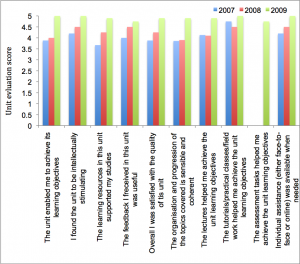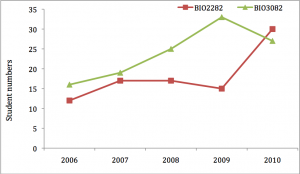It’s a green, green world: Teaching plant structure and function.
by the winners of the 2010 ASPS Teaching Award,Tim Cavagnaro, Patrick Baker, Martin Burd; Monash University
The second–year unit, Plant Structure and Function, teaches students about plant anatomy and physiology. In 2006 we developed a new curriculum that integrates the study of plant structure and function with recent methodological advances, with elements of experimental design, statistical analyses and written communication. The major components of the unit include:
Lectures
The lecture course follows the increasing complexity and key innovations of plants in an evolutionary and life-history framework emphasizing, in particular, the water–to-land transition. Topics are presented in two–week blocks addressing plant structures (eg, leaves, vasculature) in the first week and exploring how they work (eg, photosynthesis, water and nutrient transport) in the second. By using an evolutionary framework, students discover why certain groups of plants have become especially successful in certain ecosystems. By integrating anatomy and physiology lectures, we have found that students develop a much stronger appreciation of the links between plant structure and function and develop a deeper knowledge of how plants work. In the final four weeks of the unit the students apply the basic building blocks of plant structure and function to explore questions related to the life histories of plants.
Practical course

Figure 1. Unit evaluation data for BIO2282 in years 2007-9 inclusive. N.B. the question relating to assessment tasks was not available in 2007-8 data.
The practical component of our unit builds on, and extends, the integrated lecture structure. To engage students in plant sciences we believe three basic requirements exist. First, the students must grow plants. Second, they must see (and measure) how the same plant species responds differently to different growing conditions. Third, they must understand (and use) the basic analytical tools required to describe these differences. To this end, we have developed a semester–long sequence of practicals in which the students grow two native Australian plant species across a range of water and light availability. The practicals are conducted in two–week blocks, in which the first week is devoted to sampling and measuring anatomical, morphological, and physiological features of the plants and the second week focuses on the data management, statistical analysis, and report writing. The experiment is a replicated, fully factorial, multi-level design, which allows us to introduce the students to increasing levels of complexity in experimental design, data analyses, and botanical techniques over the course of the semester. The early practicals focus on simple two–level comparisons with t-tests, whereas the later practicals use multi–factor ANOVA to examine interactions of water, light, and species on plant growth. This stepped approach to experimental and analytical complexity allows the students to develop the necessary skills for understanding and interpreting data of considerable complexity over the course of the semester.

Figure 2. Student numbers in BIO2282 and the following unit BIO3082 in years 2007-10 inclusive. N.B. 2010 numbers based on current enrollments.
Communication
A major theme in this unit is the importance of effective communication. We have developed an essay assessment that asks the students to explain in layman’s terms why various physical relationships expressed in mathematical equations (e.g., E=mc2) are important to life on earth in a botanical context. We then use a double–blind peer–review process in which students review each others essays, providing them with opportunities to read similar essays (but on a different equation from their own essay) critically with the goal of providing constructive feedback to their peers. Many students find this quite confronting, as they have never read other students’ work, but discover that it helps them to view their own work from a different perspective. Each student also receives at least one review from the teaching staff. The students are then given the opportunity to revise the essay prior to final submission and formal assessment.
Impact
The best evidence of success is the extraordinarily positive unit evaluations we have received in this unit in recent years, and a doubling in enrollments in 2010 (see Figs 1 and 2, Table 1). We have also seen a significant increase in student numbers in higher-level botany units, and the honours program in the School.
What were the best aspects of the unit?
Table 1. Examples of student feedback from end–of–semester unit evaluations.
|
Year |
Student comment |
| 2007 |
|
| 2008 |
|
| 2009 |
|
| For more information: |
| Dr Tim Cavagnaro, Monash Soil Ecology Group (soilecology.org), School of Biological Sciences, Monash University, Clayton, Victoria, 3800 |
| T: +61 03 990 55793; E: timothy.cavagnaro@monash.edu |
| URL: |
